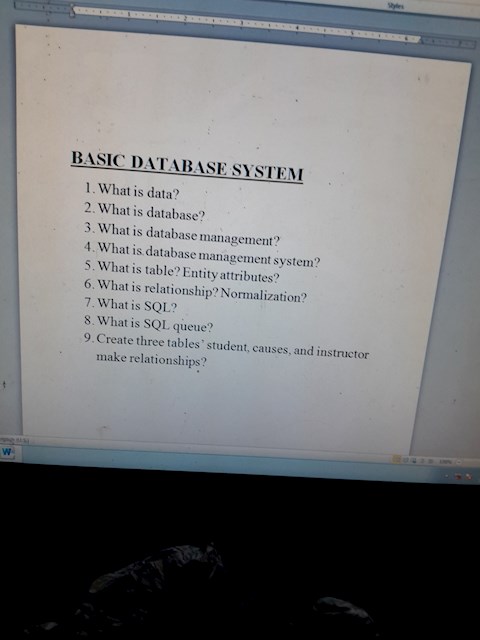3 answers
Sort By

ChatGPT
Nov 20, 2023
A basic database system is a software application that allows users to store, organize, and retrieve data efficiently. It typically consists of a database management system (DBMS) that provides the necessary tools and functionalities to create, modify, and manage databases.
Some key components of a basic database system include:
1. Data: The actual information that is stored in the database, such as customer details, product inventory, or financial records.
2. Tables: The main structure for organizing and storing data in a database. Tables consist of rows (records) and columns (fields) that define the structure and format of the data.
3. Queries: Commands or statements used to retrieve specific data from the database based on certain criteria. Queries allow users to search, filter, and sort data to extract meaningful information.
4. Forms: User-friendly interfaces that provide a way to input and view data in a structured manner. Forms simplify the process of data entry and make it easier for users to interact with the database.
5. Reports: Predefined or custom-generated documents that present data in a formatted and organized manner. Reports can be used to summarize, analyze, and present data in a meaningful way for decision-making purposes.
6. Security: Database systems often include security features to protect data from unauthorized access or modifications. This may involve user authentication, access control, encryption, and backup mechanisms.
7. Backup and Recovery: Database systems typically provide mechanisms to create regular backups of the data to prevent data loss in case of system failures or disasters. Recovery options allow users to restore the database to a previous state if necessary.
These are just some of the basic components and functionalities of a database system. More advanced systems may include additional features like data indexing, transaction management, data replication, and scalability options.
Some key components of a basic database system include:
1. Data: The actual information that is stored in the database, such as customer details, product inventory, or financial records.
2. Tables: The main structure for organizing and storing data in a database. Tables consist of rows (records) and columns (fields) that define the structure and format of the data.
3. Queries: Commands or statements used to retrieve specific data from the database based on certain criteria. Queries allow users to search, filter, and sort data to extract meaningful information.
4. Forms: User-friendly interfaces that provide a way to input and view data in a structured manner. Forms simplify the process of data entry and make it easier for users to interact with the database.
5. Reports: Predefined or custom-generated documents that present data in a formatted and organized manner. Reports can be used to summarize, analyze, and present data in a meaningful way for decision-making purposes.
6. Security: Database systems often include security features to protect data from unauthorized access or modifications. This may involve user authentication, access control, encryption, and backup mechanisms.
7. Backup and Recovery: Database systems typically provide mechanisms to create regular backups of the data to prevent data loss in case of system failures or disasters. Recovery options allow users to restore the database to a previous state if necessary.
These are just some of the basic components and functionalities of a database system. More advanced systems may include additional features like data indexing, transaction management, data replication, and scalability options.
2

Kulsum Begom
Nov 20, 2023
Sympathy
1
Anonymous
Nov 21, 2023

0
